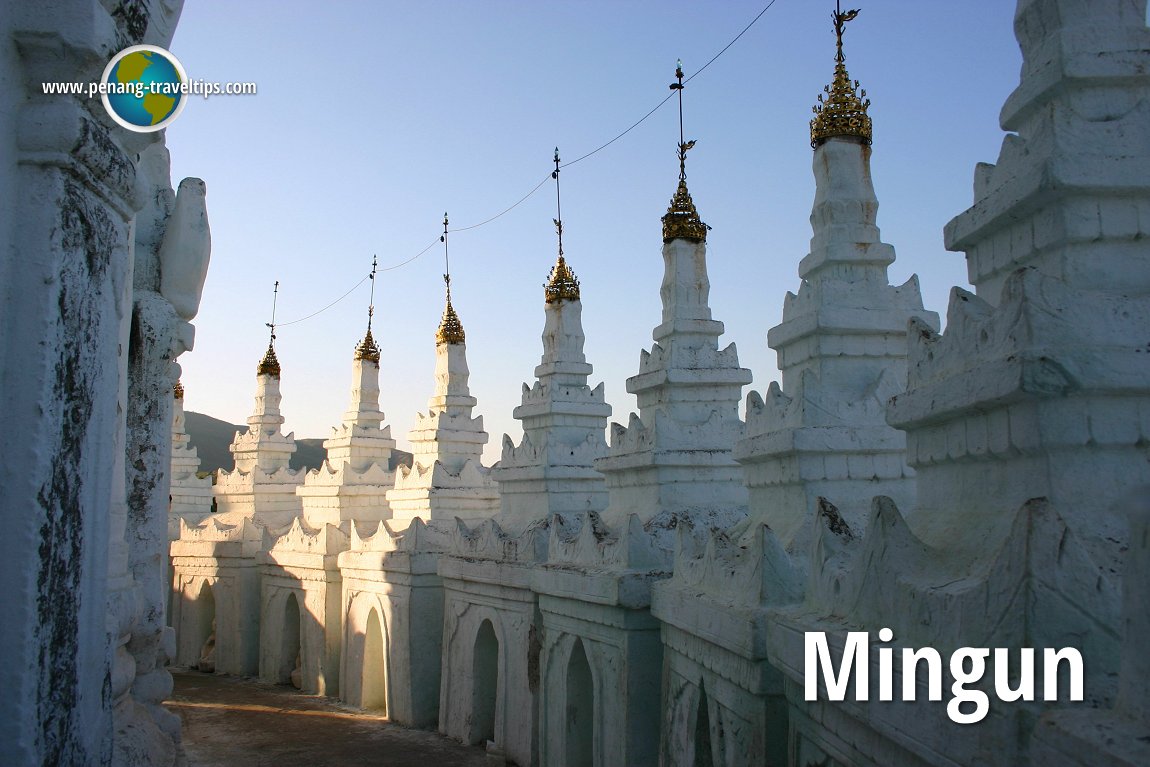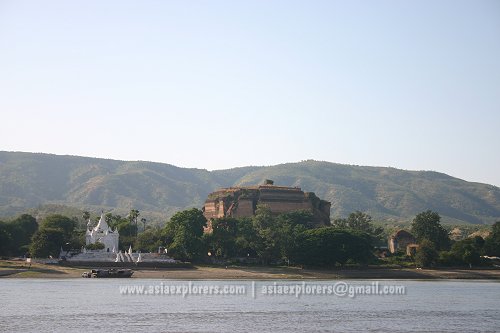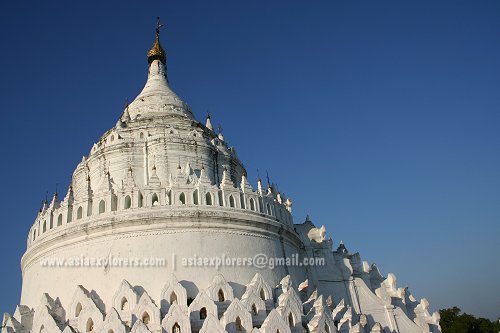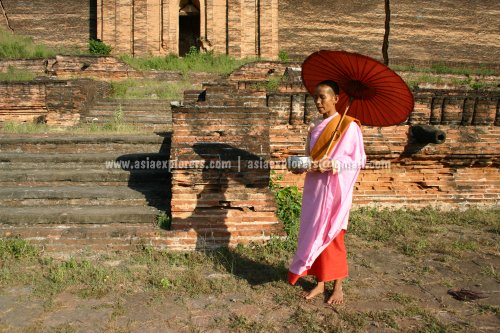 Mingun, Myanmar (23 November, 2003)
Mingun, Myanmar (23 November, 2003)
Mingun is a village on the west bank of the Ayeyarwady River. It is located to the north of the Sagaing hills. Although it has never been a capital, unlike Inwa, Amarapura and Mandalay, but it holds its own as home to two world-record superlatives.
Visitors to tiny Mingun will find the world's largest intact bell, one that can still toll. It was made for an unfinished pagoda. Remnants of this unfinished pagoda, still visible in Mingun, is described as the "world's largest pile of bricks". If completed, this pile of bricks would have been the world's largest pagoda.
Sights in Mingun
 Mingun Pagoda as seen from the Ayeyarwady River (23 November 2003)
Mingun Pagoda as seen from the Ayeyarwady River (23 November 2003)
In front of this brick pile is a massive sculpture which is in ruins. This is all that remains of what would have been the world's largest guardian lion-dog - the chinthe. Only the hind portion remains, and it still reaches a formidable height.
Mingun is reachable from Mandalay by boat across the Ayeyarwady. The journey takes about an hour upriver from Mandalay to Mingun, and 40 minutes downriver from Mingun back to Mandalay. Even from far, you can see the Mingun Pagoda, as it is so huge. Along the way, you see ferries, bamboo rafts and diesel-powered riverboats, and fishermen in their small sampans.
 Mya Theindan Pagoda, also called Hsinbyume Pagoda (23 November 2003)
Mya Theindan Pagoda, also called Hsinbyume Pagoda (23 November 2003)
Mingun is where you can see ambitious and vanity get the better of men, and it comes in the form of the incomplete Mingun Pagoda, also known as Mantara Gyi Pagoda and Mingun Pahtodawgyi. The pagoda was conceptualised by King Bodawpaya. Having just succeeded in bringing the Maha Muni Buddha from Rakhaing to Amarapura, and becoming owner of a white elephant, he wanted to further emphasize his supremacy by putting up the world's tallest pagoda. The intended height was 500 feet.
Construction lasted from 1790 to 1797. And then, labour problems brought it to a halt. Unable to get workers, and compounded by economic crisis at the beginning of the 19th century, Bodawpaya could not complete his pagoda project. When he died in 1813, none of his children continued the building. Nonetheless, even as it stood, it was a massive sight, and if anything, claims the record as the world's biggest pile of bricks.
 Nun at the Mingun Pagoda (23 November 2003)
Nun at the Mingun Pagoda (23 November 2003)
A short distance north of the incomplete pagoda is the bell intended for it. Just as the pagoda, the Mingun bell was cast to monstrous dimensions. Weighing 87 tons and standing at 12 ft, it is the world's biggest bell that is still used.
Getting there
You can reach Mingun by boat from Mandalay. Either negotiate with a boat at the Mandalay pier or arrange through a travel agent. All the sights in Mingun are within walking distance.Mingun Travelogue, 23 November, 2003
Mingun was the final destination for a day that included visiting Amarapura and Sagaing on the earlier part of the day. We had to arrive at Mingun around 3:30pm, since the boat journey alone would have consumed close to two hours. It was a great experience to travel on the boat to Mingun, passing clusters of riverside huts on stilts, and watching life along Myanmar's main artery.Upon arriving in Mingun, we first visited the Mingun Pagoda. Seeing that the sun was already descending on the western horizon, I hurried to the other side of the pagoda, to get the best blue skies. I was not disappointed. It was a clear day and rewarded me with a deep blue sky.
From the pagoda, we continued to explore the Mingun bell. I even climbed under the bell. The bell is covered with graffiti, which is a shame, for a see a lot of it the handiwork of tourists. Guard should have been stationed at this heritage object to prevent such a defilement.
The final attraction we visited was the Hsinbyume Pagoda, which is a beautiful white-wash structure. In between, we had the opportunity (or rather, the opportunity was pressed on us) to do a little bit of souvenir shopping. I bought an umbrella which our tour guide Henry told me I couldn't use anywhere in Myanmar. Why not? Because it's a monk's umbrella, and in Myanmar, only monks are allowed to use it. I still have it stored in the storeroom of my house today.
 Latest updates on Penang Travel Tips
Latest updates on Penang Travel Tips
 Map of Roads in Penang
Map of Roads in Penang
Looking for information on Penang? Use this Map of Roads in Penang to zoom in on information about Penang, brought to you road by road.
Copyright © 2003-2025 Timothy Tye. All Rights Reserved.

 Go Back
Go Back